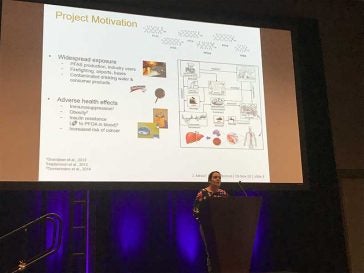
PFAS substances have unique properties that make their transport in the human body difficult to predict. Like other environmental toxicants, when PFAS enter the human body, the potential for damage or adverse health impacts may be limited by how efficiently they are able to transport throughout the body. Although some PFAS molecules prefer to bind to proteins, others are likely to interact with fats. Alesio’s research at URI focuses on the importance of both of those mechanisms and how to predict the transport of PFAS in the body.
Binding constants are an important factor when modeling PFAS transport in the body and Alesio‘s presentation focused on data from three different experimental techniques to determine binding constants of PFAS with serum albumin – the most abundant protein in the blood. Serum albumin is also responsible for transporting fatty acids throughout the body and other researchers have shown that PFAS bind to it. Two of three methods looked at how the protein responded to PFAS binding and the final method investigated how the PFAS molecule itself responded to binding. Each of these methods produced different results, underscoring the need to complete many different experiments with varying methods in order to accurately define binding constants.
The ultimate goal of this work is to develop accurate models that predict how PFAS travel through the human body. Since there are over 4,000 PFAS chemicals, it is critical to develop methods to extrapolate findings from a small number of PFAS to the entire group.

